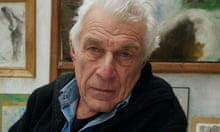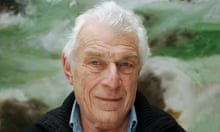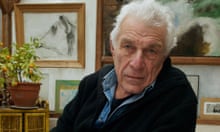During a relatively warm period in the last Ice Age the climate in Chauvet, in south-eastern France was between 3C and 5C colder than it is today. The trees were limited to birches, Scots pine and juniper. The fauna included many species that are now extinct: mammoths, megaceros deer, cave lions without manes, aurochs and bears that were three metres tall, as well as reindeer, ibex, bison, rhinoceros and wild horses. The human population of nomadic hunter-gatherers was sparse and lived in groups of 20-25. Paleontologists name this population Cro-Magnon, a term that distances at first, yet the distance may turn out to be far-fetched. Neither agriculture nor metallurgy existed. Music and jewellery did. The average life expectancy was 25.
The need for companionship while alive was the same. The Cro-Magnon reply, however, to the first and perennial human question, "Where are we?" was different from ours. The nomads were acutely aware of being a minority overwhelmingly outnumbered by animals. They had been born, not on to a planet, but into animal life. They were not animal keepers: animals were the keepers of the world and of the universe around them, which never stopped. Beyond every horizon were more animals.
At the same time, they were distinct from animals. They could make fire and therefore had light in the darkness. They could kill at a distance. They fashioned many things with their hands. They made tents for themselves, held up by mammoth bones. They spoke. (So, perhaps, did animals.) They could count. They could carry water. They died differently. Their exemption from animals was possible because they were a minority, and, being a minority, the animals could pardon them for this exemption.
Silence. I turn off the helmet lamp. A darkness. In the darkness the silence becomes encyclopedic, condensing everything that has occurred in the interval between then and now.
On a rock in front of me a cluster of red squarish dots. The freshness of the red is startling. As present and immediate as a smell, or as the colour of flowers on a June evening when the sun is going down. These dots were made by applying red oxide pigment to the palm of a hand and then pressing it against the rock. One particular hand has been identified on account of a disjointed little finger; another imprint of the same hand has been found elsewhere in the cave. On another rock, similar dots, making an overall shape, which is like the side view of a bison. The marks of the hands fill the animal's body.
Darkness.
Before the women, men and children arrived (there is a footprint of a child of about 11 in the cave) and after they left for good, the hiding-place was inhabited by bears. Probably also by wolves and other animals, but the bears were the masters with which the nomads had to share the cave. On wall after wall the scratches of bear paws. Footprints show where a bear walked with her cub, feeling her way in the dark. In the largest of the cave's chambers, which is 15 metres high, there are numerous wallows or depressions in the clay on the ground, where bears lay asleep during their hibernation. One hundred and fifty bear skulls have been found here. One of them had been solemnly placed - probably by a Cro-Magnon - on a rock plinth in the furthest reach of the cave.
Silence.
In the silence, the extent and size of the place begins to count for more and more. The cave is half a kilometre long and in places 50 metres wide. But geometrical measurements do not apply because one is inside something like a body. The standing and overhanging rocks, the enclosing walls with their concretions, the passages, the hollow spaces that have developed through the geological process of diagenesis, resemble, to a remarkable degree, the organs and spaces within a human or animal body. What they all have in common is that they look like forms created by flowing water.
The colours of the cave, too, are anatomical. The carbonate rocks are bone and tripe coloured, the stalagmites scarlet and very white, the calcite draperies and concretions orange and snotty. Surfaces glisten as if wet with mucous. A massive stalagmite has grown (they grow at the rate of one centimetre per century) to look somewhat like a stomach's intestines, and, at one point in their descent, the tubes suggest the four legs, tail and trunk of a miniature mammoth. The reference could easily be missed and so a painter, with four brief lines in red, has brought the tiny mammoth nearer.
Many walls that might have lent themselves to being painted on have not been touched. The 400-odd animals depicted here are distributed as discreetly as in nature. There are no pictorial displays as in Lascaux or Altamira. There is more emptiness, more secrecy, perhaps greater complicity with the darkness. Yet, although these paintings were made 15,000 years earlier, they are, mostly, as skilful, observant and graceful as any of the later paintings. Art, it would seem, is born like a foal that can walk straight away. Or, to put it less vividly (everything is vivid in the dark): the talent to make art accompanies the need for that art; they arrive together.
I crawl into a low cup-shaped annex - four metres in diameter - and there, drawn in red on its irregular curving sides, are three bears, male, female and cub, as in the fairy story to be told many millennia later. I squat there, watching. Three bears and behind them two small ibex. The artist conversed with the rock by the flickering light of his charcoal torch. A protruding bulge allowed the bear's forepaw to swing outwards with its awesome weight as it lolloped forward. A fissure followed precisely the line of an ibex's back. The artist knew these animals absolutely and intimately; his hands could visualise them in the dark. What the rock told him was that the animals - like everything else that existed - were inside the rock, and that he, with his red pigment on his finger, could persuade them to come to the rock's surface, to brush against it and to stain it with their smells. Today, due to the humid atmosphere, many of the painted surfaces are as sensitive as a membrane and could easily be wiped off with a rag. Hence the reverence.
Step outside the cave and re-enter the wind-rush of time passing. Reassume names. Inside the cave everything is present and nameless. Inside the cave there is fear, but the fear is in perfect balance with a sense of protection. The Cro-Magnons did not live in the cave. They entered it to participate in certain rites about which little is known. The suggestion that they were, in some way, shamanistic seems convincing. The number of people at any given time in the cave may never have exceeded 30.
How frequently did they come? Did generations of artists work here? No answers. Perhaps there never will be. Perhaps we have to be content with intuiting that they came here to experience, and to carry away with them in memory, special moments of living a perfect balance between danger and survival, fear and a sense of protection. Can one hope for more at any time?
Most of the animals depicted in Chauvet were in life ferocious, yet nowhere is there a trace of fear. Respect, yes, a fraternal respect. And this is why in every animal image there is a human presence. A presence revealed by pleasure. Each creature here is at home in man - a strange formulation, yet incontestable.
In the furthest chamber, two lions drawn with charcoal in black. Approximately life size. They stand side by side in profile, the male behind, the female, touching the length of him and parallel to him, nearer to me. They are here as a single, incomplete (their forelegs and back paws are missing and, I suspect, were never drawn) yet total presence. The rock-face around them, which is lion-coloured, has become lion. Probably here it was the colour of the rock that was on offer to the painter, for completion with his drawing of the animals.
I try to draw the two of them. The lioness is both beside the lion and inside him. This ambivalence is the result of the most cunning elision, whereby the two animals share a contour. The low contour of loin, belly and chest belongs to them both, and they share it with an animal grace. For the rest their contours are separate. The lines of their tails, backs, necks, foreheads, muzzles are independent, approaching one another, parting, converging and ending at different points, for the lion is much longer than the lioness. Two standing animals, male and female, joined below by the single line of their bellies, where they are most vulnerable and have less fur.
I'm drawing on absorbent Japanese paper, which I chose because I thought the difficulty of drawing with black ink on such paper might take me a little closer to the difficulties of drawing with charcoal (which was burnt and made here in the cave) on rough rock surfaces. In both cases the line is never quite obedient. One has to nudge, cajole.
Two reindeer are stepping in opposite directions, east and west. They do not share a contour; instead they are drawn over each other, so that the upper one's forelegs cross the flank of the lower one, like large ribs. And they are inseparable, their two bodies locked into the same hexagon, the little tail of the upper one rhyming with the lower one's antlers. They are making a single sign, and they are dancing in a circle to make this sign.
When the drawing was almost complete, the artist abandoned charcoal and painted and rubbed in with a finger a thick black (the colour of your hair after swimming) along the lower one's belly and dew lap. Then he did the same thing with the upper animal, mixing the paint with the whitish sediment on the rock so that it was less violent. As I draw, I ask myself whether my hand, obeying the visible rhythm of the reindeer's dance, may not be dancing with the hand that first drew them. It is still possible here to come upon a crumb of broken charcoal that fell to the floor when a line was being traced.
Several herds heading west. Among them, near animals, drawn very small, touch gigantic faraway animals. Cro-Magnon painting did not respect borders. It flows where it has to, deposits, overlaps, submerges images already there, and it continually changes the scale of what it carries. What kind of imaginative space did they live in?
For nomads the notion of past and future is perhaps subservient to the experience of elsewhere. Something that has gone, or is awaited, is hidden elsewhere in another place. For both hunters and hunted hiding well is the precondition for survival. Life depends upon finding cover. Everything hides. What has vanished has gone into hiding. An absence - as after the departure of the dead - is felt as a loss but not as an abandonment. The dead are hiding elsewhere.
Commentators remark with astonishment that the paleolithic painters knew the rudiments of perspective. When they say this, they are thinking of Renaissance perspective. The truth is that anyone at any time who draws or has drawn, knows very well that some things are nearer and others further away. What changes is how this experience of observing some things coming forward and others receding, is pictorially articulated within the dominant view of what space means. This view changes from culture to culture. Perspective is not a science but a hope. Traditional Chinese art looked at the earth from a Confucian mountain top; Japanese art looked closely around screens; Italian Renaissance art surveyed conquered nature through the window or door-frame of a palace. For the Cro-Magnons space is a metaphysical arena of continually intermittent appearances and disappearances.
A male ibex, with curved horns as long as its body, has been drawn with charcoal on whitish rock. How to describe the blackness of its traces? It is a blackness that makes the darkness reassuring, a blackness that is a lining for the immemorial. He is walking up a gentle incline, his steps delicate, his body rounded, his face flat. Each line is as tense as a well- thrown rope, and the drawing has a double energy that is perfectly shared. The energy of the animal who has become present, and that of the man's arm and eye drawing it by torch light. These rock paintings were made where they were so that they might exist in the dark. They were for the dark. They were hidden in the dark so that what they embodied would outlast everything visible, and promise, perhaps, survival.
The Cro-Magnons lived with fear and amazement in a culture of Arrival, facing many mysteries. Their culture lasted for some 20,000 years. We live in a dominant culture of ceaseless Departure and Progress that has so far lasted two or three centuries. Today's culture, instead of facing mysteries, persistently tries to outflank them.








